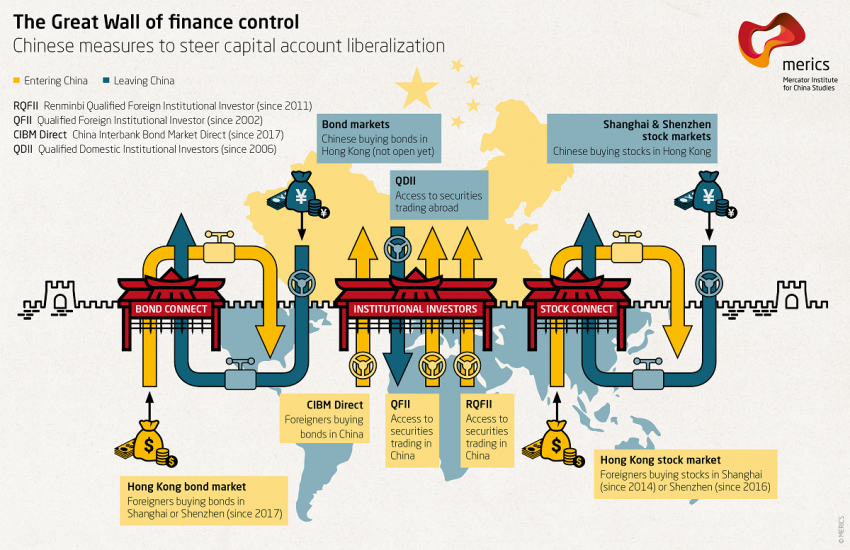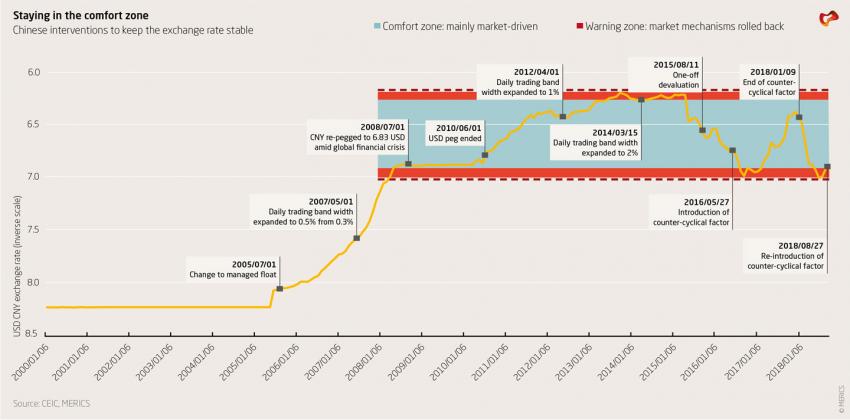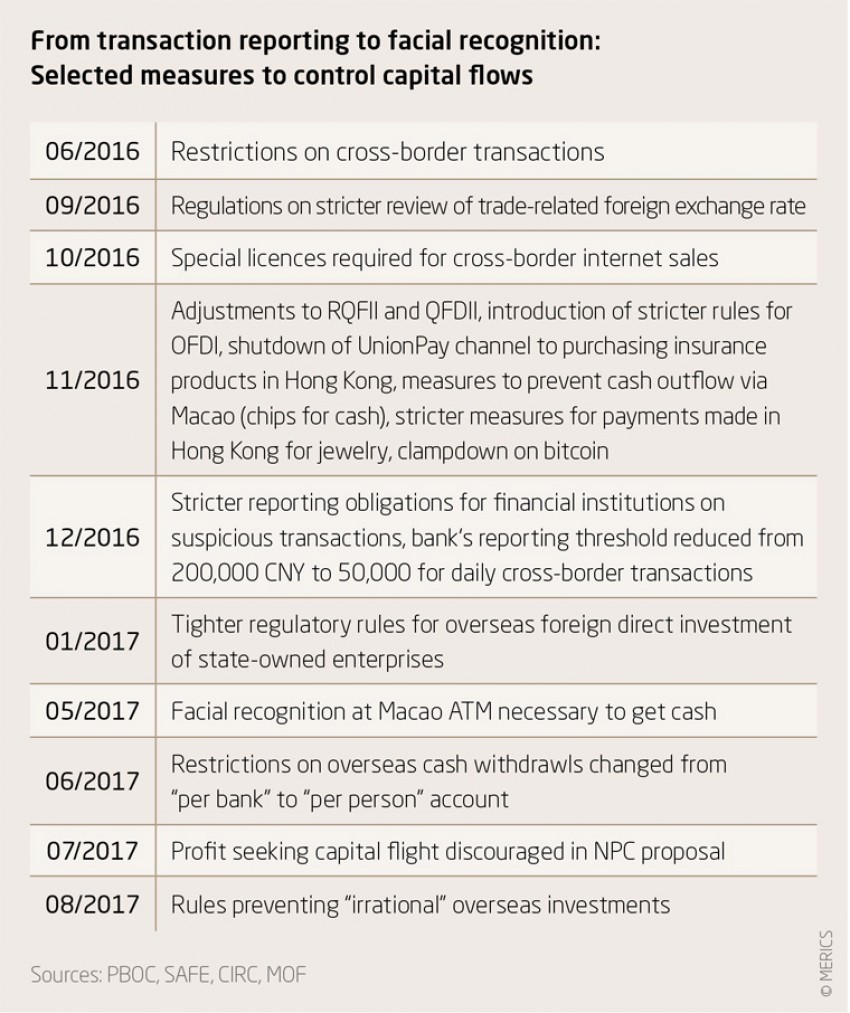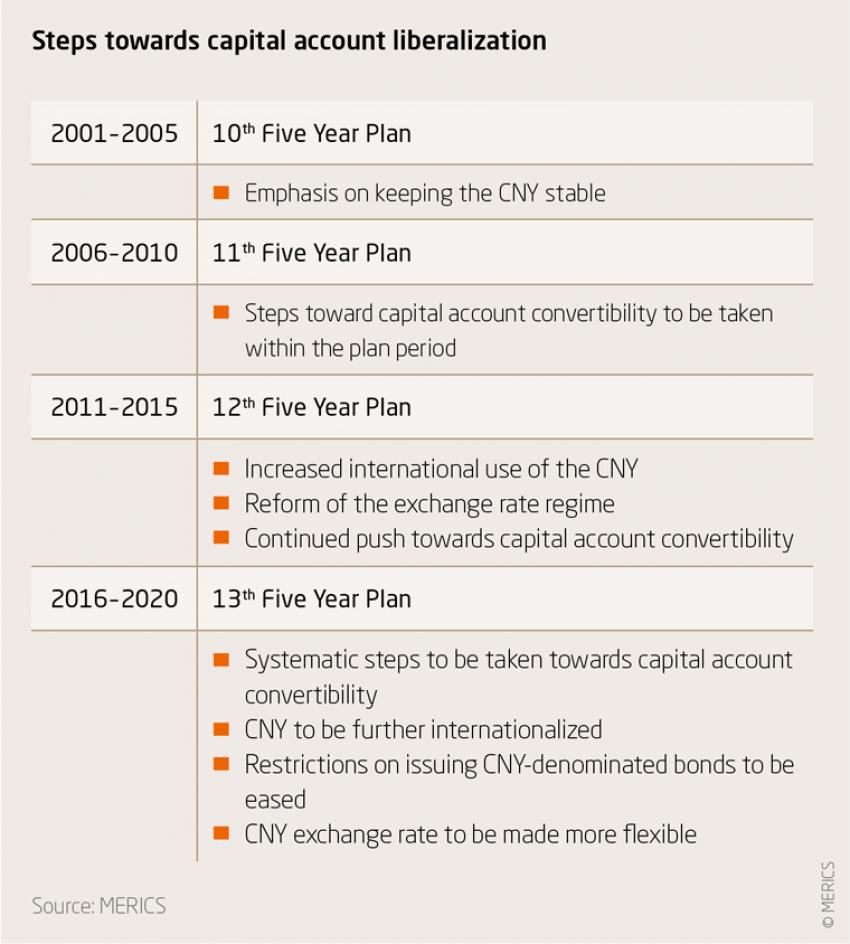

China's caution about loosening cross-border capital flows
Fear of financial instability will continue to slow the liberalization of the capital account
Main findings and conclusions
- China is adjusting its management of cross-border capital flows in response to changing economic conditions. Increasing capital outflows and a shrinking current account surplus have spurred Beijing to adjust the ways in which capital can move in and out of the country. It has opened new investment channels for institutional investors and more sectors of the economy to investment by foreign companies.
- China will continue to closely manage its capital account to prevent financial crises. Despite moves towards integration with the global financial system, China’s leadership has no interest in complete liberalization, which it considers incompatible with the country’s economic system. In its view, rising debts and risks to financial stability make capital controls crucial to prevent capital flight and financial crisis.
- The careful liberalization of China’s capital account comes with safeguards to prevent financial instability caused by a volatile Yuan (CNY). Worried about capital flight and influence of global financial markets, Beijing wants to maintain its power to intervene and control financial markets if need be. One result is that new investment channels are being restricted in size and come with safety mechanisms to limit negative impacts in the event of a crisis.
- China’s greater integration with the global financial system does not mean a fully convertible capital account is imminent. Foreign capital has never had better access to China’s financial market and Chinese investors’ access to global financial markets has also improved. Despite new interlinkages, Beijing’s desire for control and dislike of market-induced volatility make full capital account liberalization unlikely.
- International views on China’s capital account liberalization should be shaped by actions not words. China’s pledges need to be measured against actual steps. The International Monetary Fund has made the Yuan a reserve currency and global financial indices now include Chinese stocks – likely premature rewards for a financial system that remains tightly controlled and limits liquidity of investments.
1. Changing economic needs are nudging China towards capital account liberalization
Since China’s reforms began 40 years ago, international partners have hoped it would fully liberalize its capital account. Western economists see it as a benchmark for reform and Chinese economists have endorsed it as a long-term goal. Five-Year Plans – including the current 13th – have endorsed the goal, and a series of policy changes can be seen as steps towards it. But there is no reason to believe full capital account liberalization is imminent.
China’s integration with global financial markets is already deeper than ever before. China is the world’s second largest economy, its policy decisions about its financial system have effects all over the globe. China’s goal of becoming a global manufacturing powerhouse shook the world economy after its WTO-accession in 2001. Now its growing financial footprint could radically alter the global financial order – and its domestic financial system.
In response to changing domestic and foreign needs, China’s leadership in recent years has reduced restrictions on cross-border financial transactions. But these moves towards full capital account convertibility have seen the country’s leaders balance new economic realities and growing aspirations in global finance with the demands of domestic economic stability.
China’s leadership is keenly aware of the threat that uncontrolled capital movements pose to its ability to control the economy. Yet it also regards as vital for China’s economic development new mechanisms to encourage international institutional investors, to link China’s stock and bond markets with global markets, to help foreign financial institutions do more business in China.
This China Monitor explores this dual perspective and asks how we should understand China’s 2018 financial-sector liberalization. It examines pressure for change, potential benefits of capital account liberalization, and recent changes to China’s financial mechanisms that are meant to expand its global role and preserve control over capital flows.
2. Cautious capital account liberalization is global integration with a Chinese twist
Aware of the pros and cons of current account convertibility, China’s leadership is pursuing limited liberalization. It is learning about the dynamics and effects of capital flows, while remaining deeply skeptical about market mechanisms. The result has been an expanding system of loops that confines capital within a controlled system, for example, the investment channel Shanghai-Hong Kong Stock Connect, and circuit breakers designed to manage the speed of capital flows in portfolio investments.
The template for this learning-by-doing is the system of Special Economic Zones, used early in China’s opening up, in the 1980s. These experimental zones enabled Beijing to test policies on a small scale apart from rest of the economy. This ensured innovations were compatible with China’s economic system and would enable the government to retain control.
Beijing is using China’s financial market regulators to minimize the risks of capital account liberalization and push forward with reform and internationalization. Regulators appear to be pursuing the following guiding principles to keep China in its economic comfort zone:
- The Yuan must stay within the exchange-rate band of CNY 6.2-7 to the US Dollar, and China must maintain at least 3 trillion USD in foreign-exchange reserves.
- China must maintain a variety of investment channels through which capital flows can be controlled separately, for example, by suspension or reversal of transactions. These new global linkages are small, discrete, and highly regulated, allowing the government to reassert control over market mechanisms when needed.
- China must preserve its ability to intervene if market outcomes run counter to government targets. If the exchange-rate band is endangered or capital outflows risk becoming too big, the government reacts to control capital flows and their effects.
The exchange-rate movements of the CNY against the USD over the past decade show these principles in action. Since 2008, the USD-rate has moved between CNY 6.2 and 7.0, suggesting a politically defined “comfort zone”. As soon as the exchange rate nears one of the limits of this band, the People’s Bank of China (PBOC) and other regulators intervene.
When the exchange rate lingered near the upper limit for an extended period in 2013 and 2015, the PBOC surprised markets with a one-off devaluation. In mid- 2016, pressure from capital outflows saw the exchange rate touch 7.0. This led the central bank to introduce an opaque “counter cyclical factor” for setting the CNY’s daily reference rate.
In parallel, authorities fine tuned capital controls. Late 2016, foreign-exchange reserves dipped below the symbolic level of 3 trillion USD as the PBOC intervened to support the CNY. Authorities bolstered oversight of capital outflows and closed loopholes. This included efforts to stop private individuals moving funds via established channels in Hong Kong and Macao.
Our research identified around 75 multifaceted capital control adjustments between June 2016 and January 2018. Chinese regulators focused on investment channels to take targeted action against rapid capital outflow as foreign exchange reserves shrank. It proved a powerful and effective tool in responding to changing market sentiment by preventing rapid capital outflow as foreign exchange reserves began to dwindle. Policies were relaxed after the CNY stabilized – only to be reactivated in August 2018, when the CNY fell again.
3. China still views capital controls as a key element of its economic model
Controlled capital flows have been key to China’s economic stability – they protected the economy during the 1997 East Asian financial crisis and the 2008 global financial meltdown. After a rapid build-up of debt, China’s financial system is today even more vulnerable. An open capital account would give markets substantial control over the financial system. Policy makers would have to heed to market sentiment, as investors could move capital around at will.
This scenario makes the CCP uncomfortable. It considers capital controls vital for defending China’s economic model and its control of the economy. But the CCP also wants to optimize cross-border capital flows to reach economic and geopolitical goals. In pursuing these goals, the CCP is deliberately taking a gradual, strategic approach: it is wary of changing a policy that has been very successful in maintaining stability.
Under a more globally ambitious President Xi Jinping, stability and control of resource allocation remain guiding principles But policy makers are seeking to maximize the benefits of limited liberalization as China’s role as a net lender to the world is about to change. New channels for institutional investment to drive China’s global financial integration are likely. Yet new mechanisms opening China’s capital account will have safeguards to maintain CCP control. China’s leadership is far from a structural break capital account liberalization would induce on the economy.
China is willing to accept the price for this – slower progress in establishing its financial system and currency as keystones of the global order. Much of China’s rapid economic growth hinged on a predictable exchange rate, pegged to the USD, and on a sovereign monetary policy that gave the People’s Bank of China (PBOC) control over interest rates.
The Asian Financial Crisis 1997 – an important lesson for China
The Asian Financial Crisis showed how seemingly healthy economies can suffer severe damage through the combination of large-scale foreign inflows and an inefficient banking system. The Chinese leadership learned important lessons from the crisis, which hurt a number of fast growing East Asian economies that had opened their capital accounts. China’s defense of its currency peg to the US dollar and its maintenance of strict capital controls ensured it was largely unaffected by the crisis.
When the crisis struck, South Korea, Thailand, Malaysia, Indonesia, and the Philippines largely had open capital accounts with fixed exchange rate regimes. While GDP grew strongly, these countries had profited from large and sustained inflows of capital. However, these funds were invested mainly in more liquid portfolio investments, rather than more productive fixed assets such as factories. The boom years also saw a rapid accumulation of debt, denominated both in USD and the domestic currencies.
From 1993 to 1995, a series of rapid interest-rate increases by the US Federal Reserve and deteriorating market sentiment left many East Asian economies exposed as capital flows reversed and flowed out of these markets. To defend their currencies, central banks raised interest rates significantly. Depreciating currencies and high interest rates forced many domestic debtors to default, unleashing an economic crisis. Booming economies were hit hard as jobs, savings and personal wealth evaporated.
This pair of policy goals enabled a form of “financial repression” that fueled China’s investment and export-led growth model. With strict capital controls keeping capital inside the country, interest rates on deposits could be “repressed” to levels equal to or lower than the inflation rate. This in turn enabled the government to allocate cheap credit to government bodies and state-owned enterprises (SOEs), spurring swathes of domestic investment.
But capital controls have isolated China’s financial system from global markets, and left it dominated by domestic bank lending. The bountiful availability of funding led to stellar GDP growth, but also had negative side effects: rapidly rising debt and non-performing loans, industrial overcapacities, zombie companies, unregulated shadow banking, and asset bubbles. Continued restrictions on free capital flow shield the exchange rate and monetary policy from these vulnerabilities.
There are difficult trade-offs to be made in liberalizing the capital account. A country cannot simultaneously have a fixed exchange rate regime, free capital flow, and maintain a sovereign monetary policy. This is known as the “impossible trinity” in macroeconomic theory, as central banks can only achieve two of these three policy targets simultaneously.
Once capital controls are loosened, a stable currency requires the central bank to manage interest rates to prevent investors seeking higher returns abroad. The outcome is often a more volatile exchange rate – an effect emerging markets faced as the US Federal Reserve raised interest rates in 2018. Capital controls have enabled the PBOC to keep its rates low.
Japan, Denmark, Thailand, and South Korea are reminders that capital account liberalization often pitches a country into a financial or exchange-rate crisis.1 It is a major shift that can entail unknown consequences. The severity and duration of knock-on effects can be kept down by ensuring favorable conditions at the time the capital account is opened – a stable economic environment, robust banks, developed financial markets, a fairly valued currency.2
China lacks most of these factors and has even openly conceded the vulnerability of its financial system by launching a deleveraging campaign. Xi recently warned CCP officials to be on guard against “black swans”, or unexpected events that could hurt the economy, as well as “grey rhinoceroses”, known risks that are ignored too long. He pledged to close over-indebted zombie companies, help businesses stabilize jobs, and support property prices.3
To open its capital account, China’s leadership would also have to be confident about the strength of the political system in the face of greater economic volatility. A financial crisis could lead to social unrest – the 1997 Asian Financial Crisis is still seen as a stark warning (see box).
4. China also recognizes the need for closer links to global financial markets
China’s restrictive capital account policy provided a foundation for its stable economic development. But Beijing recognizes four imperatives for reducing limits on free capital flows:
- Falling current account surplus requires policy adjustment
- Chinese companies have started investing overseas
- Its financial markets would profit from more outside scrutiny and pressure to reform
- Pressure to reform, its global influence goes hand in hand with internationalizing its currency
Firstly, China’s economy has expanded more than tenfold since 2000 and its financial system even more – from 2000 to 2018, M2 money supply, the broad money aggregate, increased more than 12 times. China’s large trade surplus led to huge foreign exchange reserves. Mainly in USD, these reserves have allowed the PBOC to defend the CNY.
But current account surplus and foreign exchange reserves have peaked. Both are now declining in relation to GDP, making it harder for the PBOC to defend the exchange rate and react to shocks. The shift to consumption-driven growth and possibly a current account deficit will hamper China’s economic-policy flexibility and its ability to manage the CNY.
The growth of the financial system has raised the volume of capital flowing in and out of the country to levels that make it difficult for authorities to react to shocks. In a piece for MERICS, Victor Shih (2017)4 calculated that if 10 percent of China’s money supply were moved abroad, the country’s foreign currency reserves would be used up. Limits on capital flows will become less effective and possibly cause volatility as the current account surplus shrinks further.
It is unlikely China will be able to maintain foreign currency reserves large enough to defend its economic model. Instead, managing capital flows will become increasingly important. By easing restrictions on the capital account, foreign capital would be able to enter the country’s financial system and help make up for the outflow of capital from a capital account in deficit.
Secondly, increases in outbound investment by Chinese companies and their need for external financing have reversed the pattern of China’s investment of the last 40 years. Traditionally, foreign direct investment (FDI) was funneled into manufacturing, while Chinese companies invested little beyond China’s borders, resulting in a net inflow of capital.
This began to change around 2010 as the Chinese leadership set out more global ambitions for the country and its companies. Outbound investment surged, driven by rising cross-border mergers and acquisitions (M&A) by Chinese companies. In 2016, there was a net outflow of capital as Chinese companies acquired a string of technology assets around the globe.
Despite recent efforts by the EU and the USA to screen Chinese overseas investments, Chinese companies are set to continue their global expansion. The ambitious Belt and Road Initiative (BRI), for one, will need considerable capital outflow to finance overseas infrastructure. Also, wealthy private individuals will increasingly demand to diversify their investments internationally – and their spending on foreign travel will also continue to rise.
Crucially, limits on capital movements have resulted in routine illegality as investors exploit loopholes to move money abroad, for example, by mis-invoicing imports. To make up for an increasing outflow of capital, China will need to open up more legal channels connecting its economy to global capital markets, both to legalize outflows and encourage more inflows.
Thirdly, capital account liberalization would subject China’s financial system to increased scrutiny from global investors. This could potentially spur China’s financial system to become more sophisticated, with more efficient capital allocation. The current regime favors bank lending to SOEs through state banks, while financing through bonds and stocks is less developed. But state banks are failing to lend sufficiently to the private sector, although it makes up more than half of China’s economy. Institutional arrangements and state influence have also contributed to a massive build-up of debt.
Capital account opening could see the private sector’s needs better met, helping China’s transition to a more sustainable growth model. Far-reaching economic effects mean capital account opening could act as a catalyst for deeper economic reforms. Much like China’s WTO entry in 2001, a reduction of restrictions on capital flows and a liberalization of the financial system could reduce the influence of vested interests in the state-dominated sector.
Lastly, although shielding its financial system and controlling its capital account has served the CCPs domestic agenda well, the present arrangement will limit China’s global leadership role.
Liberalization would stimulate the international use of the CNY, a key step for expanding China’s currently under-leveraged position in global finance. Internationalization of its currency would also spur foreign demand for a wider range and scope of CNY-denominated financial products. A bigger role for the CNY and for China in international finance would provide the foundation for eventually challenging the dominance of the US and its USD.
It gives the US control of global financial flows and power beyond the realm of economics. With over 40 percent of international payments conducted in USD, the currency and its financial infrastructure are also used for transactions between non-American partners. This allows the US to use sanctions or disrupting financial flows to project power globally.
Capital account opening would eventually give China equivalent reach. With the CNY as an alternative reserve currency to the USD, China’s leaders could limit the United States’ ability to affect China economically while increasing its ability to project financial power. To develop in economic and geopolitical terms, China needs to integrate further into the global financial system.
5. China’s leadership has reached no consensus about paths towards full liberalization
Given the radical implications for China, capital account liberalization is a sensitive political and economic issue. There are different views on the approach, scope, timing, and speed of further steps towards liberalization, both within the leadership and the financial sector.
Steps towards full convertibility of the capital account have long been part of official policy. The current 13th Five Year Plan (2016 – 2020), for instance, promises “systemic steps to realize CNY capital account convertibility, making the CNY more convertible and freely usable, so as to steadily promote the currency’s internationalization and see Chinese capital go global”. However, this consensus has not led to specific targets or a timeframe being set. Reform advocates in the CCP leadership have typically favored capital account liberalization. This is opposed by conservatives in favor of strengthening government control over large parts of the economy − for them the risk of losing control and the ability to react to a potential crisis trumps the benefits of the changes that capital account liberalization would bring.
Despite the differences in opinion between reformist and conservative camps, there is common ground in that both sides recognize the changing economic and geopolitical context. Chinese leaders seem to continue to operate with adjustable targets and flexible implementation. The result has been careful but continuous progress towards greater capital account liberalization.
The removal of some restrictions on foreign investment and trade were followed by greater liberalization of capital flows and changes to the exchange-rate regime. The current policy suits the leadership’s desire to continue capital account liberalization as and when it sees fit.
6. Unwillingness to liberalize capital flow will limit China’s global ambitions
The measures China has taken to loosen controls on its capital account are far from radical. A key feature has been to increase the variety of investment channels, allowing greater flexibility in capital movements. Regulators have been cautious about taking steps that could expose the economy to rapid capital flow reversals and financial-market volatility. But the expanding scope of investment channels has made control over capital flows harder.
Investments by foreigners in equities are highly liquid, unlike their traditional investments in fixed assets like factories. Fast moving portfolio investments by foreigners and pressure from Chinese investors looking for the same type of opportunities abroad are the main challenges for China’s liberalization efforts. Managing capital flows would become more difficult if these channels for capital flows were also opened to Chinese corporations and individuals.
Nevertheless, Chinese authorities have allowed investment channels, reduced regulatory requirements, and relaxed quotas. The highly regulated Qualified Foreign Institutional Investors (QFII) and RMB Qualified Foreign Institutional Investor (RQFII) schemes were a first step in 2002. The Stock Connect framework followed in 2014, giving more freedom to foreign and Chinese investors – even if the latter get their returns paid out in CNY in China. The overall impact of steps over the last 20 years remains small. Foreign ownership of Chinese stocks was 2.8 percent of market capitalization and 2.2 percent of domestic bond issues in 2018. Small steps are often celebrated as big ones by China and the financial world.
They were enough for the International Monetary Fund (IMF) to elevate the CNY to an official reserve currency in 2016, even though it is not fully convertible. Another premature-seeming accolade was MSCI’s inclusion of China-listed A-shares into its Emerging Markets Index, triggering a substantial re-allocation of capital as investment funds continue to adjust their portfolios.
China’s approach to greater integration into the global financial system is carefully engineered. It wants to maintain domestic financial stability while developing unique financial mechanisms to facilitate its global role. Despite rhetorical commitments, this means China will not move towards fully fledged capital account liberalization in the foreseeable future.
The price for maintaining control of domestic financial stability will be a significant hindrance to China’s global leadership ambitions and slow reforms of its domestic financial system. But even with these limitations, it is already clear that China’s deepening financial integration will have far-reaching consequences for the global financial system. The choices Chinese leaders will have to make over the next few years will no longer affect only China’s future.
The inclusion of the CNY in the IMF’s SDR basket and the MSCI Emerging Market Index has forced central banks to hold more Chinese currency and institutional investors to raise their holdings. Such linkages mean China’s decisions about monetary-policy and capital-flow management could become a factor in determining global interest rates and credit supply.
But It is highly likely that China will disappoint international expectations about speed and scope of financial integration. China has been rewarded for its intention to reform − rather than for actual implementation. There is a spiral of wishful misinterpretation in the West that casts China’s reform efforts as proof that it wants to transform itself into a liberal market economy. China’s leaders continually reaffirm their commitment − but always set their own pace.
China will continue with the cautious opening of its capital account which will increase the mismatch between its growing share of the world economy and its limited role in international finance. For the forseeable future, the CNY as a trading currency and offshore CNY-denominated financial products won’t fulfill their potential, and Shanghai and Shenzhen will remain primarily domestic financial centers, with Hong Kong serving as a restricted portal to the global financial system.
Seen from Beijing’s perspective, a critical downside of a limited global role for the CNY is that China will remain vulnerable to the power of the United States to enforce sanctions through its financial-system dominance − the arrest of Huawei’s CFO over Iran sanctions is a striking example. China’s fast increasing outbound investments will largely have to be priced in USD. Its internationalization will require more foreign debt and so incur higher costs, making these projects riskier.
China could find this position difficult to maintain once capital outflows push the current account into deficit. Stricter controls could lead to restrictions on capital outflows that obviate strategic goals. Economic developments look set to force China to undertake further adjustments to manage capital flows adequately.
This will add to the complexity of finding an adequate policy response without jeopardizing stability or the Chinese economic development mode. Confronted with a new economic reality, China’s leadership may no longer have the luxury of setting its own timeframe for liberalization. The need to get the domestic financial system in order will only become more pressing.
- Endnotes
-
1 | https://www.imf.org/en/Publications/WP/Issues/2016/12/31/Do-Inflows-or-Outflows-Dominate-Global-Implications-of-Capital-Account-Liberalization-in-40901
2 | https://www.imf.org/en/News/Articles/2015/09/28/04/53/sp091997
3 | https://news.cgtn.com/news/3d3d414d3459544d32457a6333566d54/index.html and https://www.reuters.com/article/us-china-economy-xi/xi-keeps-china-on-high-alert-forblack-swan-events-xinhua-idUSKCN1PF0XL
4 | Victor Shih (2017). Financial instability in China: Possible pathways and their likelihood. MERICS China Monitor, October 2017. https://www.merics.org/sites/default/files/201710/191017_merics_ChinaMonitor_42.pdf





